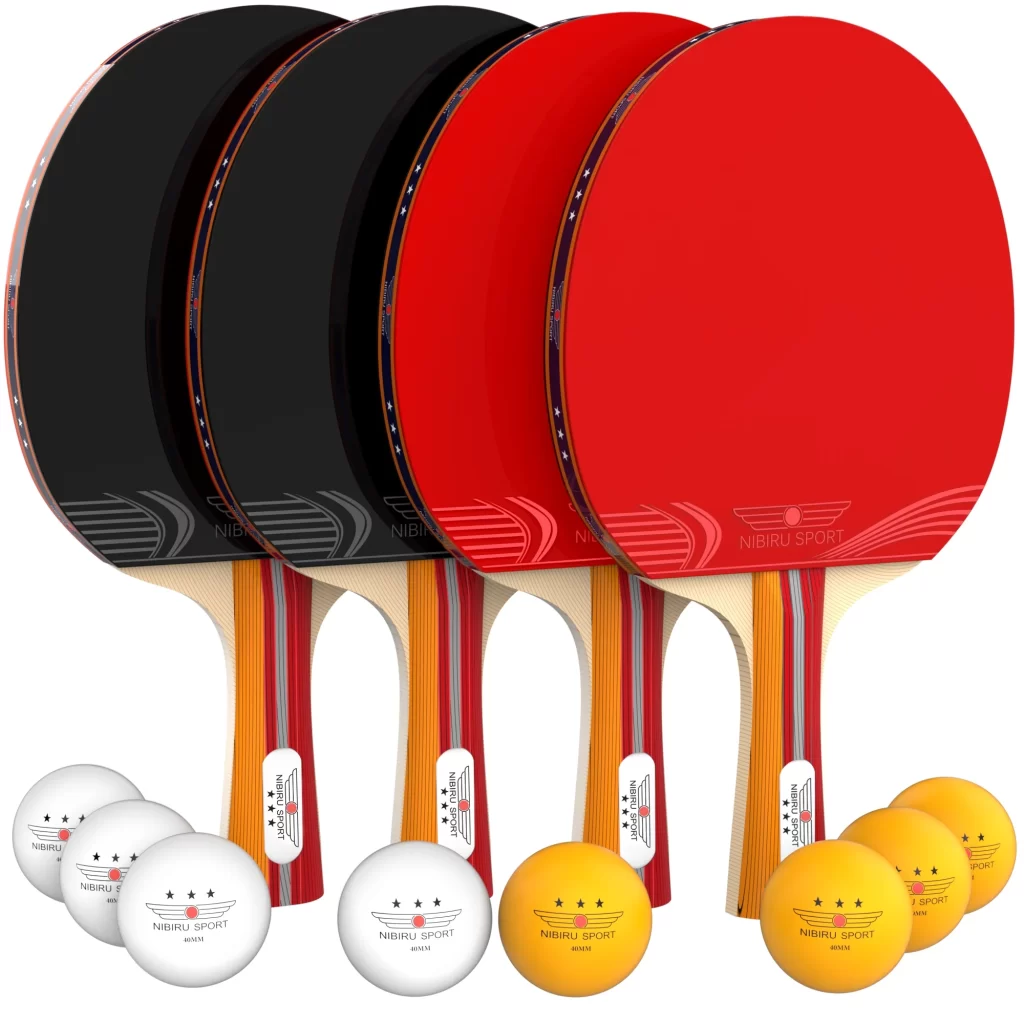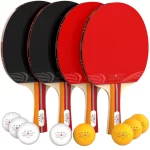Ping pong, or table tennis as it’s formally called, might seem like a simple game on the surface. Paddles whack a ball back and forth – what’s so hard about that? However, beneath the seemingly casual exterior lies a world of intricate technique. One of the fundamental aspects of mastering this game is wielding your paddle effectively. A strong grip forms the foundation for powerful strokes, precise control, and ultimately, victory.
This article delves into the fascinating world of ping pong paddle grips. We’ll explore the two main grip styles, the shakehand grip and the penhold grip, along with their variations. We’ll also discuss factors to consider when choosing your grip and provide tips for developing a comfortable and effective hold.
The Two Titans: Shakehand vs. Penhold
There are two primary grips that dominate the world of ping pong: the shakehand grip and the penhold grip. Each offers distinct advantages and suits different playing styles.
The Shakehand Grip:
Imagine shaking hands with your paddle – that’s the essence of the shakehand grip. This universally popular style offers excellent control and versatility. Here’s how to achieve it:
- Grip the handle: Hold the paddle handle much like you would shake someone’s hand. Your thumb and index finger should form a V-shape on one side, while your remaining three fingers comfortably wrap around the handle on the opposite side.
- Index finger placement: Extend your index finger along the back of the paddle blade for added stability and control over forehand strokes.
The Penhold Grip:
The penhold grip, as the name suggests, resembles how you hold a pen. It’s particularly popular in Asian countries and offers exceptional speed and maneuverability. Here’s a breakdown of the basic penhold grip:
- Handle hold: Similar to the shakehand grip, three fingers wrap around the handle, but with a more relaxed grip.
- Thumb placement: The thumb rests on the side of the handle for support.
- Forehand grip: There are two main variations – the Chinese penhold and the Japanese penhold. In the Chinese penhold, the paddle is held almost vertically, with the thumb and index finger pinching the top of the blade. The Japanese penhold has the blade tilted at a lesser angle, with all fingers stacked on the back of the handle.

Variations on a Theme: Exploring Grip Substyles
Both the shakehand grip and the penhold grip have their own substyles that cater to individual preferences and playing styles. Here’s a glimpse into some popular variations:
Shakehand Grip:
- Western Grip: This variation emphasizes a more prominent role for the index finger, offering greater power for forehand strokes.
- Eastern Grip: This grip positions the thumb further down the handle, allowing for more backhand flexibility and control.
Penhold Grip:
- Seemiller Grip: This variation of the Chinese penhold offers a more defensive style of play. The index finger rests along the side of the blade, creating a barrier for blocking shots.
- Reverse Penhold Grip: This grip essentially mirrors the shakehand grip, but with the blade held vertically. It offers a unique blend of power and touch.

Choosing Your Grip: A Balancing Act
The ideal grip ultimately depends on your playing style, hand size, and comfort level. Here are some factors to consider when making your choice:
- Playing Style: Are you an aggressive player who prioritizes power, or do you favor a more defensive, controlled style? The shakehand grip generally suits aggressive players, while the penhold grip can be advantageous for both offensive and defensive play.
- Hand Size: Players with larger hands might find the shakehand grip more comfortable, while those with smaller hands might prefer the penhold grip’s closer feel to the blade.
Developing Your Grip:
Comfort is key! Experiment with both the shakehand and penhold grips to discover what feels most natural. Here are some tips to help you develop a strong and comfortable grip:
- Start loose: Avoid gripping the paddle too tightly. A relaxed grip allows for better wrist movement and control.
- Practice makes perfect: As with any skill, perfecting your grip takes time and practice. Spend time holding the paddle in your chosen grip, focusing on feeling comfortable and in control.
- Seek guidance: Observe professional players or take lessons from a coach to refine your grip technique.

Beyond the Grip: The Journey to Table Tennis Mastery
While mastering the grip is a crucial step in your ping pong journey, it’s just the beginning. Remember, effective gameplay involves a combination of factors: footwork, stroke technique, and strategic thinking.
Footwork for Success: Moving Like a Pro
Now that you’ve grasped the fundamentals of grip (pun intended!), let’s explore another critical aspect of ping pong – footwork. Nimble footwork allows you to reach shots efficiently, maintain good balance, and transition smoothly between strokes. Here are some key footwork principles:
-
Balanced Stance: Stand with your feet shoulder-width apart and your knees slightly bent. This position provides a stable base for movement.
-
Small Steps: Don’t shuffle your feet excessively. Take small, quick steps to move around the table. This ensures you can react rapidly to your opponent’s shots.
-
Lateral Movement: Since most rallies occur side-to-side, focus on mastering lateral movement – steps to the left and right. The faster you can move laterally, the greater your court coverage.
-
Forward and Backward Movement: While less frequent, forward and backward steps are also crucial. Forward steps help you attack close to the table, while backward steps create space for defensive maneuvers.
-
Weight Transfer: As you move, focus on transferring your weight from your back foot to your front foot for powerful strokes.

Stroke Technique: Mastering the Art of Hitting the Ball
Footwork gets you in position, but stroke technique is what determines how you hit the ball. Here’s a brief overview of two fundamental strokes:
-
Forehand Stroke: This is your bread-and-butter shot, used for attacking and controlling the game. The basic motion involves swinging your arm forward, brushing the paddle across the ball to impart topspin or sidespin.
-
Backhand Stroke: This stroke is used to return shots hit to your backhand side. There are two main backhand grips – the one-handed backhand and the two-handed backhand. The one-handed backhand offers more power, while the two-handed backhand provides greater control.
Remember, mastering these strokes takes dedication and practice. Focus on proper form, coordination between your body and arm, and making consistent contact with the ball.
Strategic Thinking: Outsmarting Your Opponent
Beyond physical skills, strategic thinking elevates your game from mere mechanics to a mental battle. Here are some key strategies to consider:
-
Read Your Opponent: Observe your opponent’s playing style. Are they aggressive or defensive? What are their strengths and weaknesses? Adapt your game plan based on your observations.
-
Shot Selection: Don’t just blindly hit the ball back. Choose your shots strategically. Aim for areas your opponent struggles to reach, or use deception with spins and variations in speed.
-
Serve Smart: A good serve disrupts your opponent’s rhythm and sets you up for an advantage in the rally. Master different serving techniques, like sidespin or topspin serves, to keep your opponent off balance.
-
Mix it Up: Don’t become predictable. Alternate between powerful strokes and soft touches, and vary the placement of your shots to keep your opponent guessing.
-
Maintain Focus: Stay concentrated throughout the game. Don’t get discouraged by mistakes, and learn from each point to improve your strategy.

Putting it All Together: The Path to Ping Pong Mastery
By combining a strong grip, agile footwork, proper stroke technique, and strategic thinking, you’ll be well on your way to ping pong mastery. Remember, the journey to becoming a skilled player takes time, dedication, and a love for the game. Embrace the challenge, have fun, and enjoy the rewarding process of honing your skills.
So, grab your paddle, perfect your grip, and get ready to dominate the table tennis court!


